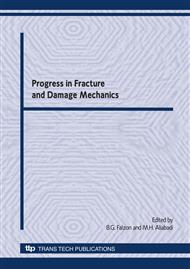p.1
p.25
p.35
p.53
p.67
p.85
p.97
p.109
Influence of Porosity on the Interlaminar Shear Strength of Fibre-Metal Laminates
Abstract:
Structures manufactured in fibre-metal laminates (e.g. Glare) have been designed considering ideal mechanical properties determined by the Classical Lamination Theory. This means that among other assumptions, perfect bonding conditions between layers are assumed. However, more than often, perfect interfaces are not achieved or their quality is not guaranteed. When in laboratory, high-quality fibre-metal laminates are easily fabricated, but in the production line the complicated manufacturing process becomes difficult to control and the outcome products may not meet the quality expected. One of the consequences may be the poor adhesion of metalprepreg or prepreg-prepreg as the result of porosity. The interlaminar shear strength of fibre-metal laminates decreases considerably, due to porosity, as the result of insufficient adhesion between layers. Small voids or delaminations lead to stress concentrations at the interfaces which may trigger delamination-propagation at the aluminiumprepreg and prepreg-prepreg interfaces at load levels significantly lower than what is achievable for perfectly bonded interfaces. Mechanical experiments show a maximum drop of 30% on the interlaminar shear strength. In the present work, the effects of manufacturing-induced porosity on the interlaminar shear strength of fibre-metal laminates are studied using a numerical approach. The individual layers are modelled by continuum elements, whereas the interfaces are modelled by cohesive elements which are equipped with a decohesion law to simulate debonding. Porosity is included in the geometry of the interface by setting some of these elements to a pre-delaminated state.
Info:
Periodical:
Pages:
35-52
Citation:
Online since:
June 2008
Authors:
Keywords:
Price:
Сopyright:
© 2008 Trans Tech Publications Ltd. All Rights Reserved
Share:
Citation:


